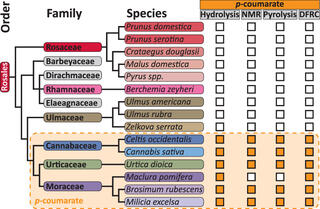p-Coumaroylated Lignins Found in Three Rosales Families

Background/Objective
The complex carbon-rich plant structure lignin can be broken down to make aviation fuel, plastics, and other commercial products. During chemical deconstruction of lignocellulosic biomass, the presence of phenolic pendant groups such as p-coumarate can improve the efficiency of deconstruction or lead to toxins that inhibit microbial fermentation of plant sugars. Though previously thought only to be in commelinid monocots, the list of pCA-containing eudicots is growing.
Approach
Lignin from 15 commercially relevant plant species in 13 families in the Rosales order of eudicots was extracted and analyzed via alkaline hydrolysis, NMR spectroscopy, pyrolysis in the presence of tetramethylammonium hydroxide, and derivatization followed by reductive cleavage (DFRC).
Results
Lignin-bound pCA was found in three Rosales families: Moraceae, Urticaceae, and Cannabaceae. Of the positive hits, the largest concentration detected was in Urtica dioica (29.1 mg/100 g of extractive-free cell wall material), followed by Milicia excelsa (5 mg/100 g), Brosimum rubescens, Celtis occidentalis, and Cannabis sativa (1.6 mg, 0.5 mg, and 1 mg/100 g respectively).
Impact
The Rosales order includes many commercially grown crops like lumber and medicinal plants. Understanding the chemical composition of their carbon-rich structures like lignin is integral to the understanding of how to break down those structures into their component parts and eventually into bioproducts.
Hellinger, J., Ralph, J., & Karlen, S. D. p-Coumaroylated Lignins Are Natively Produced in Three Rosales Families. ACS Omega, 10, 6220–6227. (2025). [DOI:10.1021/acsomega.4c11429]